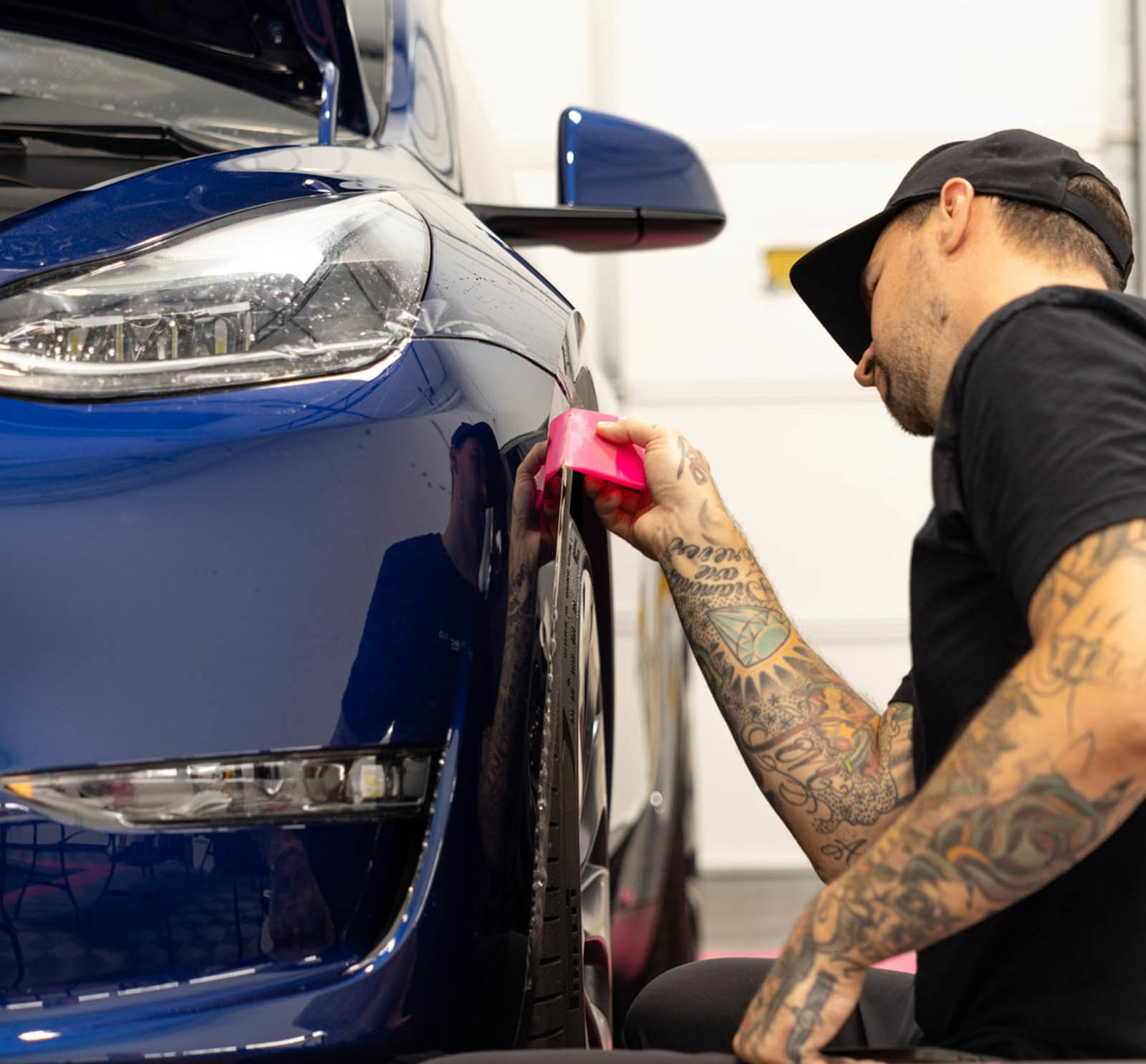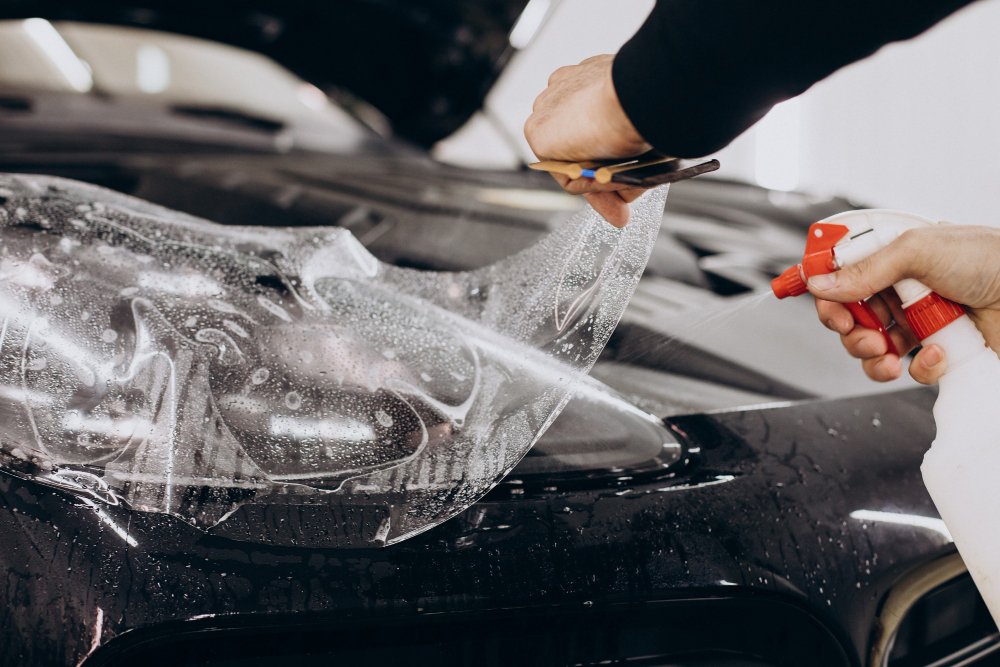To apply PPF (Paint Protection Film) on a car, clean the vehicle thoroughly and then methodically adhere the film onto the surface. Ensure a dust-free environment and use a squeegee to smooth out bubbles and wrinkles.
Applying Paint Protection Film is a strategic move to safeguard your car’s exterior from scratches, chips, and environmental contaminants. This transparent layer acts as a barrier, preserving your vehicle’s paintwork and maintaining its resale value. Professional installation is recommended, as this ensures precision, avoids damage, and guarantees longevity.
Before starting the process, the car must be meticulously washed and dried to remove any dirt that could hinder adhesion. Using the right tools and techniques is crucial for a flawless finish. Whether you’re an automobile enthusiast or a casual driver, investing the time to apply PPF correctly can keep your car looking showroom-new for years to come.
Introduction To Paint Protection Film
Paint Protection Film (PPF) is a clear, thin layer of material. It shields your car’s paint from the hazards of the road. Bugs, dirt, and minor abrasions all threaten your car’s finish. PPF is your vehicle’s invisible guardian. This film, also known as ‘clear bra,’ is applied to the exterior of cars. It blends with your car’s design. Your car stays looking pristine for years.
Benefits Of Ppf
- Prevents scratches and dents caused by rocks and road debris.
- Acts as a barrier against chemical stains and etching.
- Makes cleaning easier, repelling dirt and grime.
- Self-healing properties mend swirled and light scratches with heat.
- Preserves the car’s resale value by keeping paint in mint condition.
Evolution Of Car Protection
| Year | Innovation | Impact |
|---|---|---|
| 1960s | First protection films | Used in military applications |
| 1980s | Introduction to the automotive industry | Protection for race cars |
| 2000s | Advancement in materials and adhesives | Wider consumer adoption, better durability |
| Today | High tech PPF | Self-healing capabilities, easier to apply |

Credit: www.facebook.com
Materials Needed For Ppf Application
Embarking on the journey to apply Paint Protection Film (PPF) to your car is a smart move for the longevity of your paint job. Before diving into the process, it’s crucial to gather all materials required for a successful PPF application. A proper installation will ensure your car’s exterior is shielded from scratches, chips, and environmental contaminants. Let’s review the kits and tools needed to lay down PPF like a pro.
Types Of Ppf Kits
- Pre-Cut Kits: Tailored to fit specific car models for precision.
- Bulk Rolls: Offer flexibility for custom cuts to fit any vehicle.
Tools For A Smooth Application
With the right tools in hand, PPF installation becomes a much more manageable task. Gather these essentials:
- Slip Solution: Facilitates film positioning and reduces friction.
- Squeegees: Essential for eliminating bubbles and ensuring adhesion.
- Utility Knife: For precise trimming of the film.
- Microfiber Towels: To maintain a clean work surface and finish.
- Heat Gun: Helps stretch the film and activate the adhesive.
- Gloves: Protects hands and prevents fingerprints on the film.
Preparing Your Car For Ppf
Before you can enjoy the benefits of Paint Protection Film (PPF) on your car, it is crucial to prep your vehicle properly. Adequate preparation not only ensures the PPF adheres correctly but also maximizes its longevity and effectiveness. The following steps will guide you through cleaning and decontaminating your car’s surface, making it ready for PPF application.
Cleaning
A spotless surface is key for PPF adhesion. Start with a thorough wash, using a high-quality car shampoo. Pay special attention to spots that trap dirt, such as the bumpers, wheel wells, and under the side mirrors. Ensure you rinse the vehicle thoroughly to remove all soap residue. For best results:
- Use a clean, soft microfiber towel for drying.
- Avoid air drying as it can leave water spots.
- Ensure the car is completely dry before the next step.
Decontamination Process
Even after a wash, invisible contaminants can remain on your car’s paint. To tackle this:
- Apply a clay bar treatment to remove any embedded surface contamination.
- Move the clay bar in a back and forth motion across each section of your vehicle.
- Wipe the area with a clean microfiber cloth after treating.
- Frequently reshape the clay bar to expose a clean surface.
Proper decontamination paves the way for flawless PPF application and enduring protection for your car’s exterior.

Credit: ceramicpro.com
Step-by-step Application Guide
Protecting your car with Paint Protection Film (PPF) is an excellent choice. This durable layer keeps your vehicle’s paint job looking fresh. Let’s explore how you can apply PPF on your car step by step. Following this guide ensures a smooth, professional finish.
Cutting The Film To Size
Begin with the right tools. You’ll need a squeegee, cutting blade, and slip solution. Get a high-quality PPF roll. Your car’s model size determines the film size. Clean the area where you’ll apply the film. Always cut slightly larger than the needed size. This technique allows precise trimming later.
Applying The Film: Techniques And Tips
- Prepare your workspace by ensuring it’s dust-free. Dust causes imperfections.
- Work in sections. It makes managing the film and avoiding dirt easier.
- Mix a slip solution of water and baby shampoo. Spray generously on the car and the adhesive side of the film for easy movement.
- Position the PPF, adhesive side down. Use a squeegee to stick the film to your car. Start from the center and move outward to avoid creases.
Removing Bubbles And Imperfections
Bubbles can appear during application. Don’t worry. Use a squeegee to push them to the nearest edge. If bubbles remain, a small needle can gently puncture them. This allows you to press the air out. Work systematically across the film, removing each bubble for a smooth finish.
Aftercare And Maintenance
Once the Paint Protection Film (PPF) sets on your car, proper aftercare ensures it stays clear and strong. This film protects your vehicle’s finish. Care boosts durability and appearance. Think of your PPF as skin needing sunscreen and lotion. Proper care will keep the PPF effective. Learn about aftercare to make the most of your car’s PPF.
Sub-section Cleaning and UpkeepCleaning And Upkeep
Regular cleaning keeps your PPF sparkling and protects your investment. Start with simple steps:
- Wait a week post-installation before washing to let PPF bond completely.
- Opt for soft cloths or sponges, avoiding abrasive materials.
- Use pH-neutral car shampoos; harsh chemicals can damage the film.
- Rinse thoroughly to prevent soap residue from diminishing shine.
Avoid high-pressure washers directly on film edges. Direct streams can lift the film. Instead, spray from a distance. Regular maintenance includes quick spot cleans. Remove bird drops and tree sap quickly. These can etch the PPF over time.
Sub-section When to Replace Your PPFWhen To Replace Your Ppf
Even the best PPF doesn’t last forever. Recognize signs for replacement:
- Look for yellowing or discoloration, common in older films.
- Check for scratches or lifting edges that can’t self-heal.
- Take note of peeling or bubbling, which signals film failure.
Quality PPFs last between 5-10 years. Lifespan depends on care, exposure, and driving habits. Replace old PPF to maintain your car’s optimal look and protection. Consult with professional installers for advice on your specific PPF’s lifespan.

Credit: www.aapcolumbus.com
Professional Vs. Diy
Deciding between professional or DIY PPF application is big. Your car deserves the best protection. Each option has pros and cons. Know the differences to make a wise choice.
Cost Analysis
Cost is a key factor in your decision. Let’s break it down:
| DIY PPF | Professional PPF |
|---|---|
| Materials cost less | Includes labor fees |
| No professional fees | High-quality materials used |
| May need tools purchase | Possible package deals |
Doing it yourself can save money upfront. Pros include everything but at a price.
Quality And Longevity Considerations
Quality and longevity affect your car’s protection. Let’s compare:
- DIY: Risk of mistakes, lower-grade materials.
- Professional: Expert application, top materials.
Professionals ensure a seamless fit. The right fit means your car stays safe longer. Doing it yourself may be less reliable.
Frequently Asked Questions Of How To Apply Ppf On Car
What Is Ppf On Cars?
Paint Protection Film (PPF) is a clear, durable film applied to a car’s exterior. It acts as a protective barrier against scratches, stone chips, and environmental elements, preserving the car’s paintwork and overall appearance.
How Long Does Car Ppf Last?
Quality PPF can last between 5 to 10 years, depending on the brand and conditions of use. Proper maintenance and care can extend its longevity, making it a valuable investment for vehicle protection.
Can I Apply Ppf To My Car Myself?
Yes, you can apply PPF to your car yourself. It requires patience, precision, and a clean working environment. For an optimal finish, many prefer professional installation due to the precision and expertise involved.
What Are The Benefits Of Applying Ppf?
Applying PPF to your car provides benefits like paint protection from scratches, UV resistance, and a self-healing feature for minor abrasions. It maintains a glossy finish, enhances resale value, and keeps your car looking newer for longer.
Conclusion
Wrapping up, mastering PPF application ensures your car’s paint remains pristine. Take your time, use the right tools, and consider a professional touch when needed. Protecting your vehicle not only maintains its appearance but also its value. Dive into the world of paint protection; your car deserves that extra layer of care.
- How Much Does a Ford 9N Tractor Weigh - May 20, 2024
- How Many of My Exact Car were Made: Uncovering the Rarity - May 20, 2024
- How to Find Out What Someone Drives: Discover the Truth - May 20, 2024
